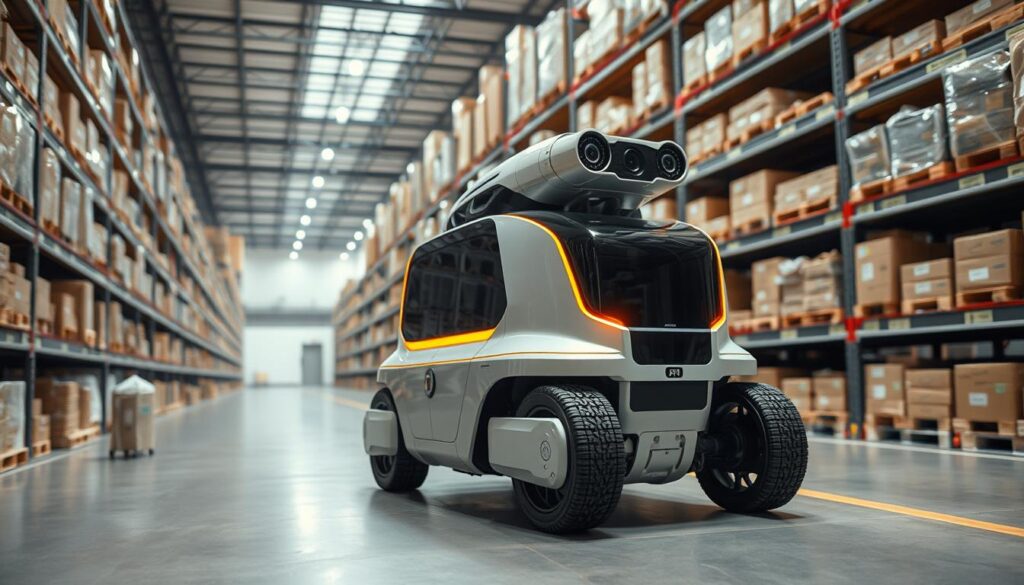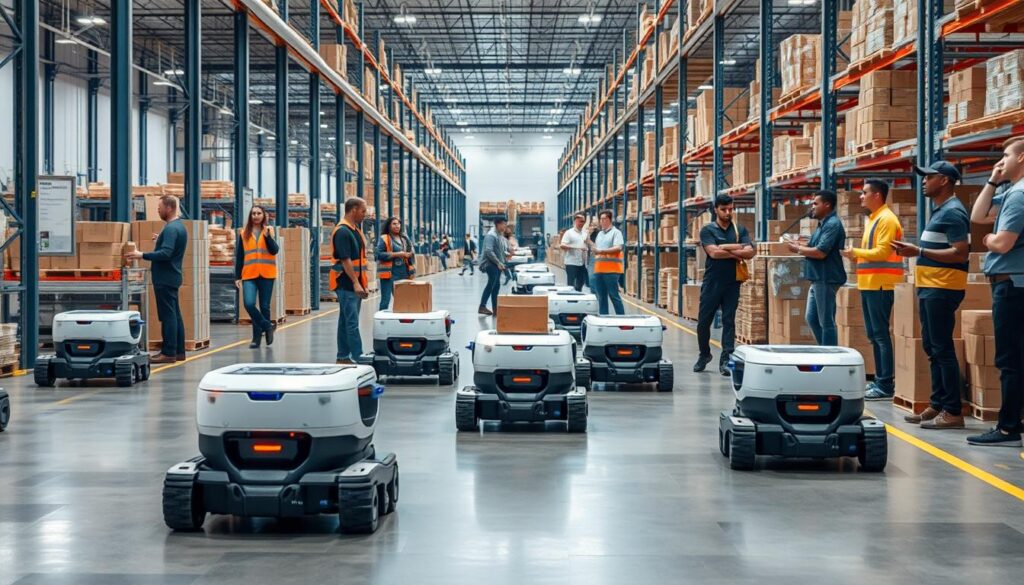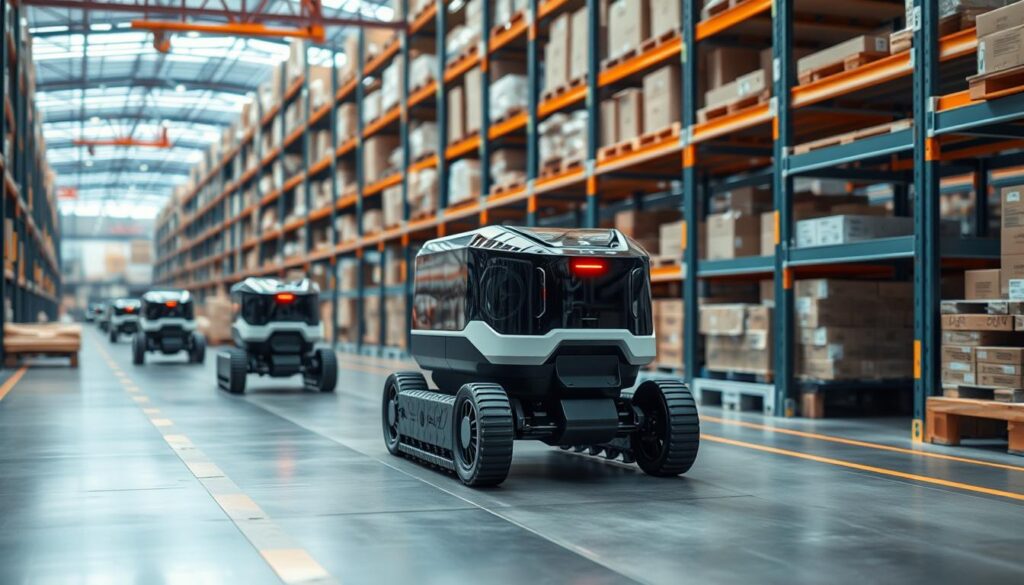In today’s fast-changing world, autonomous mobile robots (AMRs) are changing how industries work. AMRs are smart, self-moving machines that can go anywhere without fixed paths. They help make work better, safer, and more efficient in many fields, like making things, moving goods, and in healthcare.
AMRs are different from older robots because they can adapt easily. They use smart sensors and algorithms to move around and handle changes. This makes them great for working in places that are always changing, helping with tasks like moving things and working with people.

Key Takeaways
- Autonomous mobile robots (AMRs) are intelligent, self-navigating machines that can move freely within their environment
- AMRs offer enhanced flexibility and adaptability compared to traditional automated guided vehicles (AGVs)
- AMRs utilize advanced sensors, algorithms, and real-time decision-making to navigate complex environments and optimize workflows
- AMRs are transforming industries by improving productivity, efficiency, and safety in areas like manufacturing, logistics, and healthcare
- Understanding the core components and functionality of AMRs is crucial for businesses looking to implement this cutting-edge automation technology
Understanding the Basics of AMR Technology
Autonomous Mobile Robots (AMRs) are changing the game in many industries. They’re making tasks easier and more efficient. To understand their power, we need to look at their key parts.
Core Components of AMR Systems
AMRs have advanced technologies like sensor technology, robotic navigation, and machine learning. These work together to help AMRs see their surroundings, plan paths, and adjust to new situations.
How AMRs Navigate Their Environment
AMRs use SLAM (Simultaneous Localization and Mapping) to understand their space. They gather data from sensors like laser scanners, cameras, and ultrasonic sensors. This lets them map their area and know where they are.
Key Differences Between AMRs and AGVs
AGVs follow set paths and need physical guides. But AMRs are more independent. They can change their path, adapt to new situations, and make decisions on their own. This makes AMRs better for today’s industries.
“AMRs are redefining the way we approach automation, unlocking a new era of flexibility and efficiency in various industries.”
What are autonomous mobile robots (AMRs)?
Autonomous mobile robots (AMRs) are a big step forward in Industry 4.0. They change how tasks are done in many fields. These robots use artificial intelligence and sensors to move and work on their own, without needing people to help them all the time.
AMRs can see their surroundings, plan their path, and do tasks by themselves. They use new technologies to change how they move and work. This makes them very good at getting things done in different places.
AMRs are different from old robots because they can move around and make decisions on their own. They can go through tight spaces and move between different areas. This makes them very useful in places like factories, warehouses, and for moving things around.
The things that make AMRs special include their ability to:
- Navigate on their own with advanced sensors and mapping
- Change how they move based on what’s around them
- Work with people and other robots in the same space
- Make things more efficient and productive in many areas
As more industries want to automate and be more flexible, AMRs will be key in the future of Industry 4.0 and beyond.
| Feature | Description |
|---|---|
| Autonomous Navigation | AMRs use sensors, mapping, and AI to move around without needing a set path or human help. |
| Adaptability | AMRs can change how they move and their path based on what’s around them, like obstacles or new tasks, to stay efficient. |
| Collaborative Capabilities | AMRs are made to work with people, fitting into different places to make things more productive and safe. |
“The rise of autonomous mobile robots is transforming the way we approach automation in Industry 4.0, offering unprecedented levels of flexibility and efficiency.”
Applications and Use Cases of AMRs in Modern Industries
Autonomous Mobile Robots (AMRs) are changing many industries. They bring new ways to work better, safer, and more efficiently. AMRs are helping in places like factories, warehouses, and hospitals.
Manufacturing and Production Lines
In factories, AMRs are changing how things are made. They move stuff around, helping to make products faster and with fewer mistakes. They can also change how things are made as needed.
Warehouse and Logistics Operations
AMRs are also helping in warehouses and logistics. They find and move items, making things run smoother and faster. This helps use space better and cuts down on mistakes.
Healthcare and Hospital Settings
In hospitals, AMRs help by carrying things like medicine and lab samples. This lets doctors and nurses focus more on patients. They also help with things like food and trash, making hospitals run better.
AMRs are very useful in many areas. They make factories work better, help with warehouse tasks, and improve healthcare. These robots are changing how we work and making things better.

| Industry | AMR Applications | Key Benefits |
|---|---|---|
| Manufacturing | Material handling, component transportation, product assembly | Improved efficiency, reduced errors, increased productivity |
| Warehousing and Logistics | Item retrieval, inventory management, order fulfillment | Optimized space utilization, enhanced workflow, reduced labor costs |
| Healthcare | Medical supply delivery, specimen transport, hospital logistics | Streamlined operations, improved patient experience, increased staff productivity |
Benefits and Advantages of Implementing AMRs
Adding autonomous mobile robots (AMRs) to your work can bring many benefits. These include better productivity and safer workplaces. They are changing how businesses work, giving them an edge in a tough market.
AMRs can make your work more efficient. They handle tasks that need to be done over and over, making your workflow smoother. They work all the time, never needing a break, so your work keeps moving forward.
AMRs also help save money. They reduce the need for people to do manual work and cut down on mistakes. Plus, they use less energy, which saves money too.
AMRs are great for keeping workplaces safe. They move carefully, avoiding accidents. They take on risky tasks, keeping people safe and making workplaces better.
AMRs are also flexible and can grow with your business. They fit into your current work flow easily. They work well with people, making your team stronger.
“Integrating AMRs into our operations has been a game-changer. We’ve seen big improvements in productivity, cost savings, and safety. Their flexibility has helped us grow and adapt.”
– Jane Doe, Operations Manager at ABC Manufacturing
More and more businesses are using AMRs. They get to enjoy the benefits of better work, saving money, and safer places. This helps them succeed and grow for the long term.

Challenges and Considerations in AMR Deployment
Using autonomous mobile robots (AMRs) in factories comes with its own set of challenges. From the cost of starting up to making sure they work well with what you already have, it’s all about planning and doing it right.
Initial Implementation Costs
One big worry is the cost of starting up with AMRs. Buying the robots, setting them up, and keeping them running can be expensive. Companies need to think about if the benefits will be worth it in the long run.
Integration with Existing Systems
Making AMRs work with what you already have can be tricky. It’s important to make sure they talk to other systems smoothly. This needs careful planning and the right skills to get it right.
Staff Training Requirements
Getting your team ready for AMRs is key. They need to know how to use, fix, and work with the robots. Good training and support can help everyone feel comfortable and excited about the change.
| Challenge | Strategies for Overcoming |
|---|---|
| Initial Implementation Costs | Do a detailed cost-benefit analysis to see if it’s worth it Look into financing options like leasing or starting small Focus on areas where AMRs can make a big difference |
| Integration with Existing Systems | Work with experts in system integration Make sure everything works together smoothly Start small to avoid big problems |
| Staff Training Requirements | Create detailed training programs for your team Offer ongoing help and support Encourage a culture of learning and change |
By tackling these main challenges, companies can successfully use AMRs. This technology can really change how things work, but it needs careful planning and effort.
“The key to successful AMR integration is balancing the technological advancements with the human element. Empowering and training our workforce is just as important as the robotic systems themselves.”
Conclusion
Autonomous mobile robots (AMRs) are changing the game in industrial automation. They use advanced tech like laser navigation and AI to move around with great precision. This makes them very efficient in complex spaces.
The AMR industry is set to grow fast, with experts predicting exciting times ahead. As the AMR future develops, these robots will be key in pushing industrial innovation. They will help in many areas, from making things to handling goods and even in healthcare.
If you’re in business or just interested in tech, knowing about AMRs is important. They can make your operations more productive and cost-effective. This puts your company ahead in the fast-changing world of robotic automation trends.
FAQ
What are the key features of autonomous mobile robots (AMRs)?
AMRs have smart features like navigation, avoiding obstacles, and adapting to new places. They use sensors, machine learning, and AI to move on their own. This means they don’t need set paths or special setups.
How do AMRs differ from traditional industrial robots?
AMRs are different because they can move around and go where they need to. They can work in many places, like factories, warehouses, and hospitals. This is unlike fixed industrial robots.
What are the core components of an AMR system?
An AMR system has sensors, like LIDAR and cameras, and smart algorithms for navigation. It also has a computer and can talk wirelessly. These parts help the robot move and do tasks on its own.
How do AMRs navigate their environment?
AMRs use SLAM and sensor fusion to map and track their space. This lets them plan and avoid obstacles. It’s how they move around by themselves.
What are the key differences between AMRs and AGVs?
AMRs and AGVs differ in how they move. AGVs follow paths or tracks, while AMRs use sensors and algorithms to go where they need. This makes AMRs more flexible and independent.
What are the primary applications of AMRs in modern industries?
AMRs are used in many fields, like making things, managing warehouses, and in healthcare. In making things, they help with moving parts and checking quality. In warehouses, they help with stock and orders. In healthcare, they carry supplies and help with patient care.
What are the key benefits of implementing AMRs?
Using AMRs can make things more efficient and save money. They work all the time and don’t get tired. This means they can do more and make fewer mistakes. It also makes the workplace safer.
What are the potential challenges in deploying AMRs?
Starting to use AMRs can be expensive and needs careful planning. You also need to train staff. But, with the right plan, AMRs can really help your business grow.